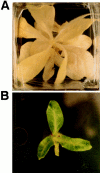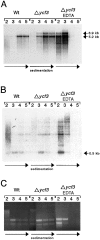Targeted inactivation of a tobacco intron-containing open reading frame reveals a novel chloroplast-encoded photosystem I-related gene
- PMID: 9314531
- PMCID: PMC2139824
- DOI: 10.1083/jcb.139.1.95
Targeted inactivation of a tobacco intron-containing open reading frame reveals a novel chloroplast-encoded photosystem I-related gene
Abstract
The chloroplast genome of all higher plants encodes, in its large single-copy region, a conserved open reading frame of unknown function (ycf3), which is split by two group II introns and undergoes RNA editing in monocotyledonous plants. To elucidate the function of ycf3 we have deleted the reading frame from the tobacco plastid genome by biolistic transformation. We show here that homoplasmic Deltaycf3 plants display a photosynthetically incompetent phenotype. Molecular analyses indicate that this phenotype is not due to a defect in any of the general functions of the plastid genetic apparatus. Instead, the mutant plants specifically lack detectable amounts of all photosystem I (PSI) subunits analyzed. In contrast, at least under low light conditions, photosystem II subunits are still present and assemble into a physiologically active complex. Faithful transcription of photosystem I genes as well as correct mRNA processing and efficient transcript loading with ribosomes in the Deltaycf3 plants suggest a posttranslational cause of the PSI-defective phenotype. We therefore propose that ycf3 encodes an essential protein for the assembly and/or stability of functional PSI units. This study provides a first example for the suitability of reverse genetics approaches to complete our picture of the coding capacity of higher plant chloroplast genomes.
Figures







Similar articles
-
Targeted inactivation of the smallest plastid genome-encoded open reading frame reveals a novel and essential subunit of the cytochrome b(6)f complex.EMBO J. 1999 Nov 1;18(21):5834-42. doi: 10.1093/emboj/18.21.5834. EMBO J. 1999. PMID: 10545095 Free PMC article.
-
A small chloroplast-encoded protein as a novel architectural component of the light-harvesting antenna.J Cell Biol. 2000 Apr 17;149(2):369-78. doi: 10.1083/jcb.149.2.369. J Cell Biol. 2000. PMID: 10769029 Free PMC article.
-
The plastid genome-encoded Ycf4 protein functions as a nonessential assembly factor for photosystem I in higher plants.Plant Physiol. 2012 Jun;159(2):579-91. doi: 10.1104/pp.112.196642. Epub 2012 Apr 19. Plant Physiol. 2012. PMID: 22517411 Free PMC article.
-
Biogenesis, assembly and turnover of photosystem II units.Philos Trans R Soc Lond B Biol Sci. 2002 Oct 29;357(1426):1451-9; discussion 1459-60. doi: 10.1098/rstb.2002.1141. Philos Trans R Soc Lond B Biol Sci. 2002. PMID: 12437884 Free PMC article. Review.
-
Balancing the two photosystems: photosynthetic electron transfer governs transcription of reaction centre genes in chloroplasts.Philos Trans R Soc Lond B Biol Sci. 2000 Oct 29;355(1402):1351-9. doi: 10.1098/rstb.2000.0697. Philos Trans R Soc Lond B Biol Sci. 2000. PMID: 11127990 Free PMC article. Review.
Cited by
-
Biochemical and structural studies of the large Ycf4-photosystem I assembly complex of the green alga Chlamydomonas reinhardtii.Plant Cell. 2009 Aug;21(8):2424-42. doi: 10.1105/tpc.108.063313. Epub 2009 Aug 21. Plant Cell. 2009. PMID: 19700633 Free PMC article.
-
Complete sequence and organization of the cucumber (Cucumis sativus L. cv. Baekmibaekdadagi) chloroplast genome.Plant Cell Rep. 2006 Apr;25(4):334-40. doi: 10.1007/s00299-005-0097-y. Epub 2005 Dec 9. Plant Cell Rep. 2006. PMID: 16362300
-
Characterization of the cyanobacterial ycf37: mutation decreases the photosystem I content.Biochem J. 2001 Jul 1;357(Pt 1):211-6. doi: 10.1042/0264-6021:3570211. Biochem J. 2001. PMID: 11415451 Free PMC article.
-
PSA3, a Protein on the Stromal Face of the Thylakoid Membrane, Promotes Photosystem I Accumulation in Cooperation with the Assembly Factor PYG7.Plant Physiol. 2017 Jul;174(3):1850-1862. doi: 10.1104/pp.17.00524. Epub 2017 May 18. Plant Physiol. 2017. PMID: 28522455 Free PMC article.
-
CO-EXPRESSED WITH PSI ASSEMBLY1 (CEPA1) is a photosystem I assembly factor in Arabidopsis.Plant Cell. 2024 Oct 3;36(10):4179-4211. doi: 10.1093/plcell/koae042. Plant Cell. 2024. PMID: 38382089 Free PMC article.
References
Publication types
MeSH terms
Substances
LinkOut - more resources
Full Text Sources
Other Literature Sources
Molecular Biology Databases

